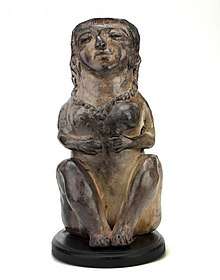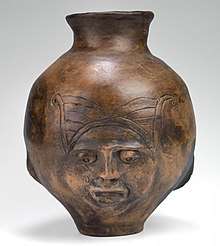Georgia Blizzard
Georgia Blizzard (May 7, 1919 - June 2, 2002) was an American ceramic artist from Virginia. She was self-taught and her work is in the permanent collections of several American art museums.
Georgia Blizzard | |
|---|---|
| Born | May 7, 1919 Saltville, Virginia |
| Died | June 2, 2002 Marion, Virginia |
| Nationality | American |
Biography
Blizzard was born in Saltville in 1919.[1] She has Apache and Irish ancestry.[2] When she was little, she and her family moved to Plum Creek.[2] Her mother taught Blizzard and her sister how to create art using a pit-fire method.[3] During the Great Depression, she left school in order to be part of the National Youth Administration.[4] She worked in a munitions factory in Bristol during World War II and after that, worked at a textile mill in Chilhowie until 1958.[5] Blizzard had contracted black lung and lost one of her lungs.[3] Her husband was crippled in an accident in a coal mine and eventually their marriage failed.[3] Her husband died in 1954.[2] Blizzard developed paranoid schizophrenia after these events and her art helped her deal with visions she saw and the feelings she needed to work through.[3]
She began making art for sale in the late 1950s and sold her pottery in her daughter, Mary's, store.[6] In the early 1980s, her neighbor, Michael Martin, contacted a friend to take some of Blizzard's work to a gallery in Buckhead run by Judith Alexander where Jonathan Williams discovered her work.[7]
Blizzard died in Glade Springs on June 2, 2002.[3]

Work

Blizzard's pottery is hand-built.[6] She used to find the material to create her ceramic art in the creek behind her house in the Appalachian hills.[8] At first, she used a coal kiln built by her neighbor, Michael Martin, but later in life used an electric kiln.[2]
She is a self-taught artist.[9] Her art "expressed her memories, surroundings, and religious views."[4] The work is dark in terms of theme, as Jonathan Williams describes it, "they make you think twice about human despair."[5]
Her work is in the permanent collections of the Smithsonian American Art Museum,[1] the American Folk Art Museum,[10] the Milwaukee Art Museum,[11] the Asheville Art Museum, the High Museum and the Abby Aldrich Rockefeller Museum.[3] Her work is also part of the private collection of the Arient family.[12]
References
Citations
- "Georgia Blizzard". Smithsonian Museum of American Art. Retrieved 12 March 2017.
- Williams 1993, p. 223.
- Smeal, Meg (2013). "Blizzard, Cheryl". In Crown, Carol; Rivers, Cheryl (eds.). The New Encyclopedia of Southern Culture. The University of North Carolina Press. pp. 227–228. ISBN 9781469607993.
- "Artist : Luce Foundation Center for American Art". Smithsonian American Art Museum. Retrieved 2017-03-13.
- Williams 1993, p. 224.
- Sellen, Betty-Carol (2016). Self-Taught, Outsider and Folk Art: A Guide to American Artists, Locations and Resources. Jefferson, North Carolina: McFarland & Company, Inc., Publishers. p. 127. ISBN 9780786475858.
- Williams 1993, p. 222.
- "Two New Exhibitions Opening at the Cleve Carney Art Gallery". Chicago Tribune. 1 September 2015. Retrieved 2017-03-13.
- Cubbs, Joanne; Hartigan, Lynda Roscoe (2001). Let It Shine: Self-taught Art From the T. Marshall Hahn Collection. Jackson, Mississippi: University Press of Mississippi. p. 50. ISBN 1578063639.
- "Mourning Urn". American Folk Art Museum. Retrieved 2017-03-13.
- "Blizzard, Georgia". Milwaukee Art Museum. Retrieved 12 March 2017.
- "Past Time". Cleve Carney Art Gallery. Retrieved 2017-03-13.
Sources
- Williams, Jonathan (1993). "Seven Outsiders". Conjunctions (21): 213–248. JSTOR 24515462.CS1 maint: ref=harv (link)
External links
- The Life and Times of Georgia Blizzard (2011 video)